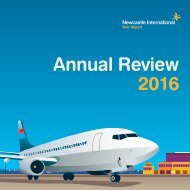Airport Masterplan 2035 LOW RES
You also want an ePaper? Increase the reach of your titles
YUMPU automatically turns print PDFs into web optimized ePapers that Google loves.
<strong>Masterplan</strong> <strong>2035</strong><br />
Strategic Rail Development<br />
9.37 The <strong>Airport</strong> works closely with key partners such as Nexus<br />
and train operators to ensure that improvements to the rail<br />
network consider connections to the <strong>Airport</strong>. Transport for<br />
the North has identified a series of rail investment priorities<br />
for the North of England 25 . Two would particularly improve<br />
rail connectivity for the <strong>Airport</strong>:<br />
l The <strong>Airport</strong>’s catchment area extends into Cumbria with<br />
the Tyne Valley Line providing services from Carlisle to<br />
the <strong>Airport</strong> via Newcastle Central Station. The service<br />
is currently limited by the frequency and speed of the<br />
rolling stock, and the limits of the non-electrified track.<br />
Northern Rail, which currently operates the route, plans<br />
to replace outdated ‘Pacer’ trains by 2019. This will vastly<br />
improve passenger comfort and the speed of the service,<br />
as well as introducing free Wi-Fi and improved luggage<br />
storage on board, both of which are vital for airline<br />
passenger patronage. There are also plans to increase<br />
the frequency of services from Carlisle. Longer term<br />
the electrification of the line would provide faster and<br />
greener services, and the <strong>Airport</strong> would fully support<br />
this investment.<br />
l The East Coast is identified as a key route for future<br />
demand and growth. The route offers good connections<br />
to Yorkshire and Southern Scotland and so any<br />
improvements to the route and its services would<br />
improve and potentially expand the <strong>Airport</strong>’s long<br />
distance catchment for public transport. The East Coast<br />
mainline suffers from constrained capacity and reliability.<br />
Network Rail is investing in infrastructure to improve the<br />
reliability of the route and allow for future services. This<br />
includes the future running of HS2 trains to Newcastle on<br />
non-high speed track, which will improve journey times<br />
and add capacity. However, issues remain, particularly<br />
north of Northallerton, where only twin tracks are in<br />
place. The route will, however, benefit from the running<br />
of newer trains such as the Hitachi ‘Azuma’ , which will<br />
add capacity, improve journey times, and provide greater<br />
comfort for passengers travelling to the <strong>Airport</strong>.<br />
9.38 Linked to the above, there will be a need for further<br />
improvements to Newcastle Central Station such as<br />
platform extensions, to add capacity and to accommodate<br />
future rail services. This may bring the need for an<br />
underground pedestrian tunnel system, linking platforms<br />
as well as adjoining business districts. To provide a true<br />
integrated transport system it is vital that such a system also<br />
provides a direct link to Central Station Metro Station. We<br />
also consider that improved way finding at Central Station<br />
with clear signage that the Metro provides an <strong>Airport</strong> link<br />
would improve the passenger journey from rail to air.<br />
Local Rail Development<br />
9.39 Two long term opportunities are identified in the draft Metro<br />
and Light Rail Strategy (2016) produced jointly by Nexus<br />
and the North East Combined Authority, to improve rail<br />
services to the <strong>Airport</strong>.<br />
l The <strong>Airport</strong> owns a parcel of land at Benton, North<br />
Tyneside, containing a former track bed with rail<br />
infrastructure removed. A long term opportunity is to<br />
reinstate this rail link via the ‘Benton Curve’ between the<br />
north bound East Coast Main Line and the west facing<br />
Metro line, which could. allow heavy rail services to travel<br />
directly to the <strong>Airport</strong>, alongside other improvements<br />
to the system’s infrastructure. This could significantly<br />
improve passenger convenience and journey times, and<br />
open the <strong>Airport</strong> up to a larger catchment for rail travel.<br />
This land has been safeguarded in the North Tyneside<br />
Local Plan (2017) for this purpose and we retain the long<br />
term strategic ambition to develop this link.<br />
l Expansion of the ‘depot avoiding line’, which removes the<br />
need for exchange at South Gosforth Metro Station. This<br />
could allow for direct, faster services to the <strong>Airport</strong> from<br />
North Tyneside and the Coast, direct heavy rail links, and<br />
potentially service from expanded local rail routes such<br />
as the Ashington, Blyth, and Tyne Line.<br />
9.40 The real opportunity for the improvement of local rail<br />
links is the linking of planned investment in local rail<br />
services to the existing Metro system at interchanges, in<br />
addition to the extension of the network. The potential<br />
reintroduction of passenger services on the Leamside Line<br />
and the Ashington, Blyth and Tyne Line would open-up<br />
a rail catchment area in County Durham and South East<br />
Northumberland respectively, providing the opportunity for<br />
increased rail/Metro passenger patronage to travel to the<br />
<strong>Airport</strong>.<br />
9.41 In addition to the planned replacement of rolling stock for<br />
the Northern Rail service on the Tyne Valley Line, new trains<br />
will also soon operate on the Durham Coast Line, resulting<br />
in faster journey times and improved passenger experience.<br />
The frequency of services are also planned to be improved.<br />
In particular this could improve rail linkages with Teesside;<br />
an area not served by the East Coast Main Line and<br />
so has low rail patronage to travel to the <strong>Airport</strong>. These<br />
improvements largely still rely on the Metro and therefore<br />
integrated ticketing and improved promotion are key.<br />
25<br />
Initial Integrated Rail Report (2017) and Draft Strategic Transport Plan (2018)<br />
56<br />
57




